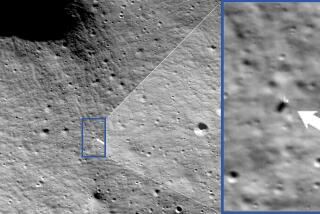Shuttle Lands; Telescope May Never Be 100%
- Share via
EDWARDS AIR FORCE BASE — The shuttle Discovery returned safely to Earth on Sunday, but even as NASA officials were congratulating the crew for launching the Hubble Space Telescope, controllers were reluctantly concluding that the $1.5-billion orbital observatory may never operate at 100% efficiency because of a balky antenna.
“We’re somewhat frustrated because we feel that even though we’re going to solve this problem, a final resolution . . . probably will not restore that antenna to complete capability,” said deputy project manager Jean Olivier at the Goddard Space Flight Center in Greenbelt, Md.
However, Olivier added, “we feel that’s not a major impact on the mission from a long-term standpoint.”
The problem involves one of the telescope’s two “high-gain” antennas, parabolic dishes on masts extending from each side of the 12-ton telescope. The antennas send data from the telescope to astronomers on Earth.
The antennas are gimbal-mounted so that they can be continuously aimed at a nearby NASA data relay satellite, which will forward the telescope’s images to the ground. But when controllers at Greenbelt tried to activate the second antenna Thursday, sensors indicated that its motor was straining, suggesting that the antenna was stuck.
Researchers believe that the antenna’s counterweight, which allows it to be moved easily, may be catching on a nearby cable, impeding its motion. “We’ve identified a cable that we suspect could be the culprit,” Olivier said.
The worst scenario is that the antenna will remain locked into one position, so that the observatory will be forced to operate with only one antenna, which would significantly reduce the data output. “At the worst, we can operate it with one (antenna),” Olivier said. “It’s not something we would want to do, but it would still be effective . . . . “
But as many as 75 engineers in Alabama, California and Maryland are attacking the problem, and they are optimistic that they will be able to restore at least 75% of the antenna’s mobility.
“Our long-term strategy is to find the area . . . which we should avoid and thereby . . . still utilize that antenna through a majority of its coverage,” Olivier said.
Discovery ended its five-day mission by taking advantage of a brief respite from the wind to return to Earth at 6:49 a.m. on a bright, gusty morning.
“Welcome back and congratulations on a super mission,” radioed controller Steve Oswald from Mission Control. “The world is waiting to reap the benefits of your work for the next 15 years.”
Although the telescope had been plagued by minor glitches ever since its release from Discovery on Wednesday, the astronauts were unaware of the problems with the antenna and were in a buoyant mood after landing.
“I, for one, am very happy to be back . . . so I can start seeing some of the results myself,” said mission specialist Bruce McCandless.
The landing was almost delayed for a day, however, by winds that were gusting up to 40 m.p.h. Overnight, Air Force weather forecasters had predicted only a 50% chance of acceptable weather for the landing, a prediction that may have contributed to the small crowd of only about 20,000 spectators who viewed the touchdown--an unusually small number for a Sunday landing.
Winds died down and remained mild--10 m.p.h. with gusts to 15 m.p.h.--until Discovery touched down, then picked up again. “They just barely squeaked in,” said a NASA official.
Because of the winds, Discovery landed on the 15,000-foot concrete runway rather than the 7-mile-long dry lake bed as NASA had originally intended. The shorter landing strip did, however, give mission commander Loren J. Shriver an opportunity to test the new carbon brakes installed on Discovery for this mission.
The new brakes are designed to shorten the stopping distance of the shuttle, which touches down at 225 m.p.h., so that it can safely land on shorter runways, such as that at Kennedy Space Center in Florida. No shuttle has landed at Kennedy since April 19, 1985, when one of Discovery’s right-side brakes locked up and a tire exploded after a touchdown in a stiff crosswind.
Although Shriver and William Lenoir, NASA’s associate administrator for space flight, agreed that the brakes worked very well, no landings at Kennedy are scheduled.
The other crew members of Discovery were pilot Charles F. Bolden and mission specialists Steven A. Hawley and Kathryn D. Sullivan. The five flew to Houston shortly after touchdown.






